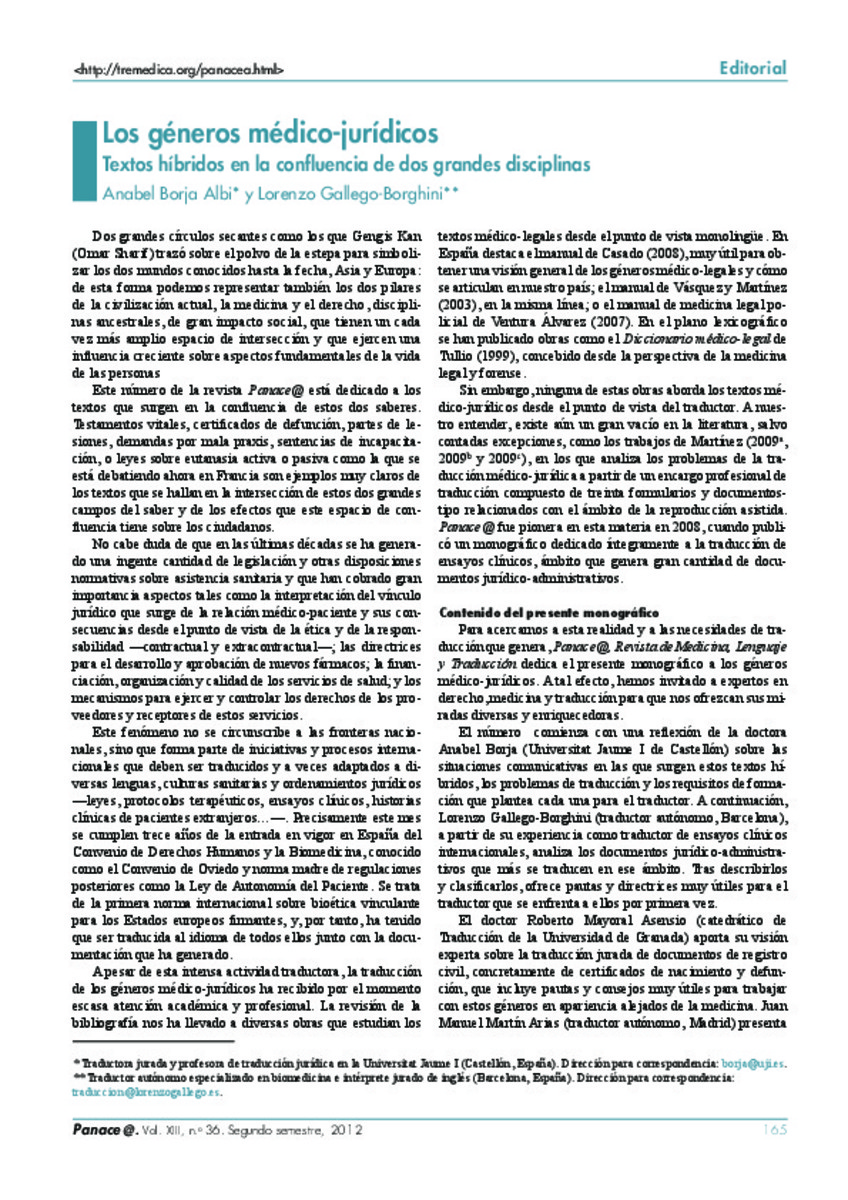Mostrar el registro sencillo del ítem
Los géneros médico-jurídicos : Textos híbridos en la confluencia de dos grandes disciplinas
| dc.contributor.author | Borja Albi, Anabel | |
| dc.contributor.author | Gallego Borghini, Lorenzo | |
| dc.date.accessioned | 2013-05-06T18:46:04Z | |
| dc.date.available | 2013-05-06T18:46:04Z | |
| dc.date.issued | 2012 | |
| dc.identifier.issn | 1537-1964 | |
| dc.identifier.uri | http://hdl.handle.net/10234/62578 | |
| dc.description.abstract | Two large intersecting circles like the ones Genghis Khan (Omar Sharif) traced in the dust of the steppes to symbolise the two worlds that were known up till then, Asia and Europe, could also be used to represent the two pillars of today's civilisation: medicine and law. The overlap between these two ancestral disciplines with a huge social impact is becoming larger and larger, and they exert an increasingly more significant influence on the most fundamental aspects of people’s lives. This issue of the journal Panace@ is devoted to the texts that arise from the meeting point between these two fields of knowledge. Wills, death certificates, injury reports, malpractice claims, disability rulings or laws about active or passive euthanasia are all very clear examples of texts that lie on the border between these two great fields of knowledge and of the effects this overlap has on citizens’ lives. This phenomenon is not limited to national borders, but is part of international initiatives and processes that have to be translated and sometimes adapted to a number of different languages, healthcare cultures and legal systems. | |
| dc.description.abstract | Dos grandes círculos secantes como los que Gengis Kan (Omar Sharif) trazó sobre el polvo de la estepa para simbolizar los dos mundos conocidos hasta la fecha, Asia y Europa: de esta forma podemos representar también los dos pilares de la civilización actual, la medicina y el derecho, disciplinas ancestrales, de gran impacto social, que tienen un cada vez más amplio espacio de intersección y que ejercen una influencia creciente sobre aspectos fundamentales de la vida de las personas. Este número de la revista Panace@ está dedicado a los textos que surgen en la confluencia de estos dos saberes. Testamentos vitales, certificados de defunción, partes de lesiones, demandas por mala praxis, sentencias de incapacitación, o leyes sobre eutanasia activa o pasiva, son ejemplos muy claros de los textos que se hallan en la intersección de estos dos grandes campos del saber y de los efectos que este espacio de confluencia tiene sobre los ciudadanos. Este fenómeno no se circunscribe a las fronteras nacionales, sino que forma parte de iniciativas y procesos internacionales que deben ser traducidos y a veces adaptados a diversas lenguas, culturas sanitarias y ordenamientos jurídicos. | |
| dc.format.extent | 2 p. | ca_CA |
| dc.format.mimetype | application/pdf | ca_CA |
| dc.language.iso | spa | ca_CA |
| dc.publisher | Tremédica. Asociación Internacional de Traductores y Redactores de Medicina y Ciencias Afines | ca_CA |
| dc.relation.isPartOf | Panace@. Revista de Medicina, Lenguaje y Traducción, 2012, vol. XIII, n. 36, segundo semestre, p.165-166 | ca_CA |
| dc.rights.uri | http://rightsstatements.org/vocab/InC-EDU/1.0/ | * |
| dc.title | Los géneros médico-jurídicos : Textos híbridos en la confluencia de dos grandes disciplinas | ca_CA |
| dc.type | info:eu-repo/semantics/article | ca_CA |
| dc.rights.accessRights | info:eu-repo/semantics/openAccess | ca_CA |
| dc.relation.publisherVersion | https://www.tremedica.org/panacea/v13-n36-diciembre-2012/ | ca_CA |
Ficheros en el ítem
Este ítem aparece en la(s) siguiente(s) colección(ones)
-
Tradmed: Màster en traducció medicosanitària [251]
Selecció de documentació en matèria de traducció medicosanitària. -
TRAD_Articles [344]
Articles de publicacions periòdiques







